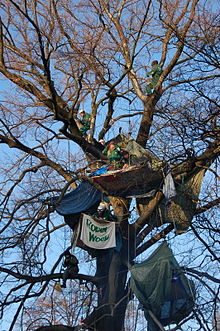Tree occupation
A tree occupation is a most effective public action form of environmentalists, to draw attention to the on an endangered by infrastructure nature. The occupied tree therefore usually represents an endangered nature. Tree occupation is a form of direct action . Violations of the law are accepted by the occupiers with reference to higher values. As a rule, tree occupations take place immediately before the expected felling. With their spectacular efforts, tree occupiers try to prevent the implementation of a decision that has already been made.
Actions
The longest tree occupation in Germany was carried out in 2010 by members of the Robin Wood Action Group . For 34 days between four and eleven people occupied an almost 300-year-old European beech in Dresden to prevent the construction of the Waldschlößchenbrücke . The occupied beech was finally cleared by a special police force and then felled.
Other sensational tree occupations in Germany were:
- in the Kelsterbach Forest near Frankfurt in 2009
- In the Hamburg-Altonaer Gählerpark , residents, supported by Robin Wood , occupied and inhabited five trees for three months in the winter of 2009/2010 , and thus successfully the felling of around 400 trees planned by Vattenfall Europe for the construction of a waste heat pipe for the under construction Moorburg coal-fired power station prevented.
- in the Stuttgart palace garden from 2010 to 2012
- in the Hambach Forest almost continuously since 2012.
- In the Treburer Oberwald east of Frankfurt am Main Airport , trees were occupied from January to November 2018, supported by Robin Wood, in order to prevent the construction of a motorway slip road to the federal motorway 5 for Terminal 3, which is currently under construction .
- Since October 1, 2019, the Dannenröder forest has been occupied by around 100 activists who are committed to saving the forest and want to prevent clearing by building the federal motorway 49 (A 49). The protest camp receives Hesse and nationwide attention.
The world's best known and longest tree occupation came from the US environmental activist Julia Butterfly Hill . She lived 738 days (over two years) on a coastal redwood in California in protest against the Pacific Lumber company . Their everyday life took place on two relatively small wooden platforms that were fastened with ropes at a height of about 60 meters. In the second year of its occupation, two members of the environmental organization Earth First! that supported the tree occupation, a third platform. This was only about 30 meters high and served as a press and visitor platform. Julia Butterfly Hill used a harness and rope for the ascent and descent and initially between the platforms. She later moved unsecured in the branches of the treetop, where she spent most of the time. The tree occupation of the approximately 600 year old redwood was successful. After negotiations, the chief of Pacific Lumber agreed on December 18, 1999 to put the tree and an area of 12,000 m² around it under protection.
See also
- Direct action
- Nonviolent Action
- Civil disobedience
- occupation
- Tree climbing
- Tree spiking
- Eco anarchism
Individual evidence
- ↑ Police end tree occupation. Süddeutsche.de, May 17, 2010, accessed on November 12, 2013 .
- ↑ At the top. (No longer available online.) Greenpeace Magazine, January 2010, archived from the original on November 13, 2013 ; Retrieved November 13, 2013 .
- ↑ Blicklicht, TU Cottbus: Moorburgtrasse stopped - tree occupation ended ( memento from January 23, 2016 in the Internet Archive ) (PDF; 286 kB), accessed on August 5, 2017
- ↑ Good promotions for K21. (No longer available online.) Robin Wood website, November 13, 2013, archived from the original on November 13, 2013 ; Retrieved November 13, 2013 .
- ^ Protest camp at the airport cleared. In: Frankfurter Rundschau. November 6, 2018, accessed November 23, 2018 .
- ↑ Tree occupation against the threat of deforestation for Frankfurt Airport - Robin Wood. In: robinwood.de. January 12, 2018, accessed January 23, 2018 .
- ^ Protest against the construction of a new airport terminal. In: welt.de . January 17, 2018, accessed January 23, 2018 .
- ↑ A visit to the activists in Dannenröder Forest: “We're not going away!” July 23, 2020, accessed on August 1, 2020 (German).
- ↑ Süddeutsche Zeitung: Trouble after the verdict on the A49 expansion: Forest occupiers remain active. Retrieved August 1, 2020 .
- ↑ Julia Butterfly Hill: The message of the tree woman , Riemann Verlag, ISBN 3-570-50015-2

